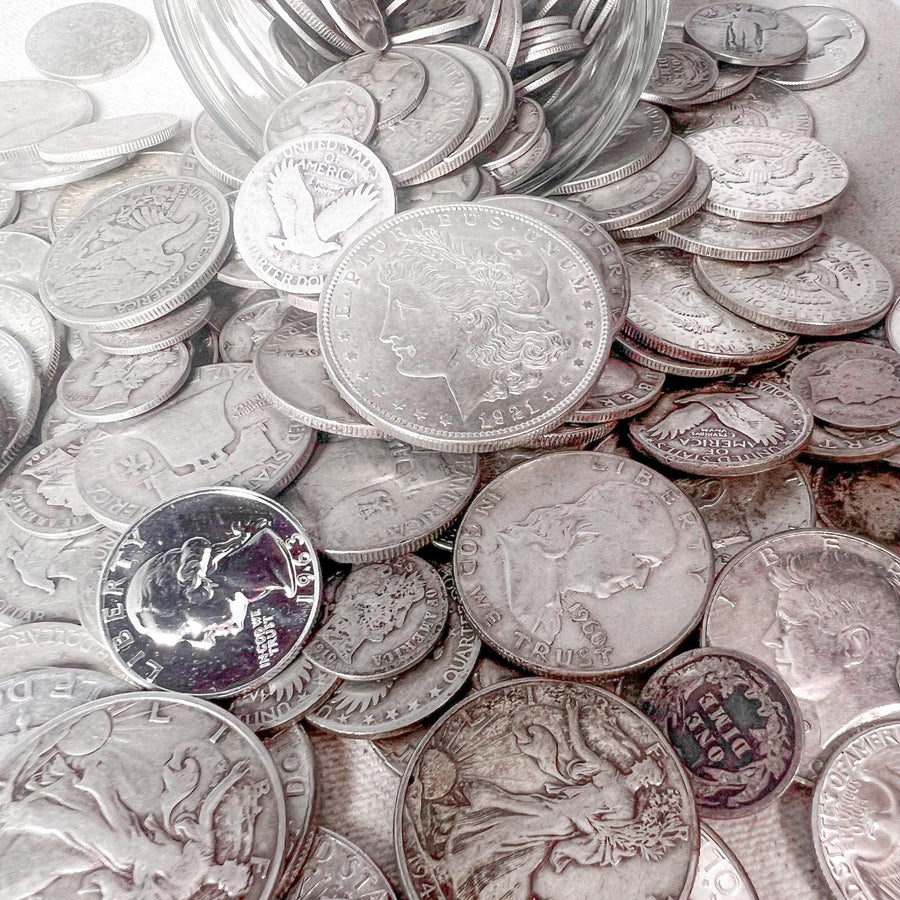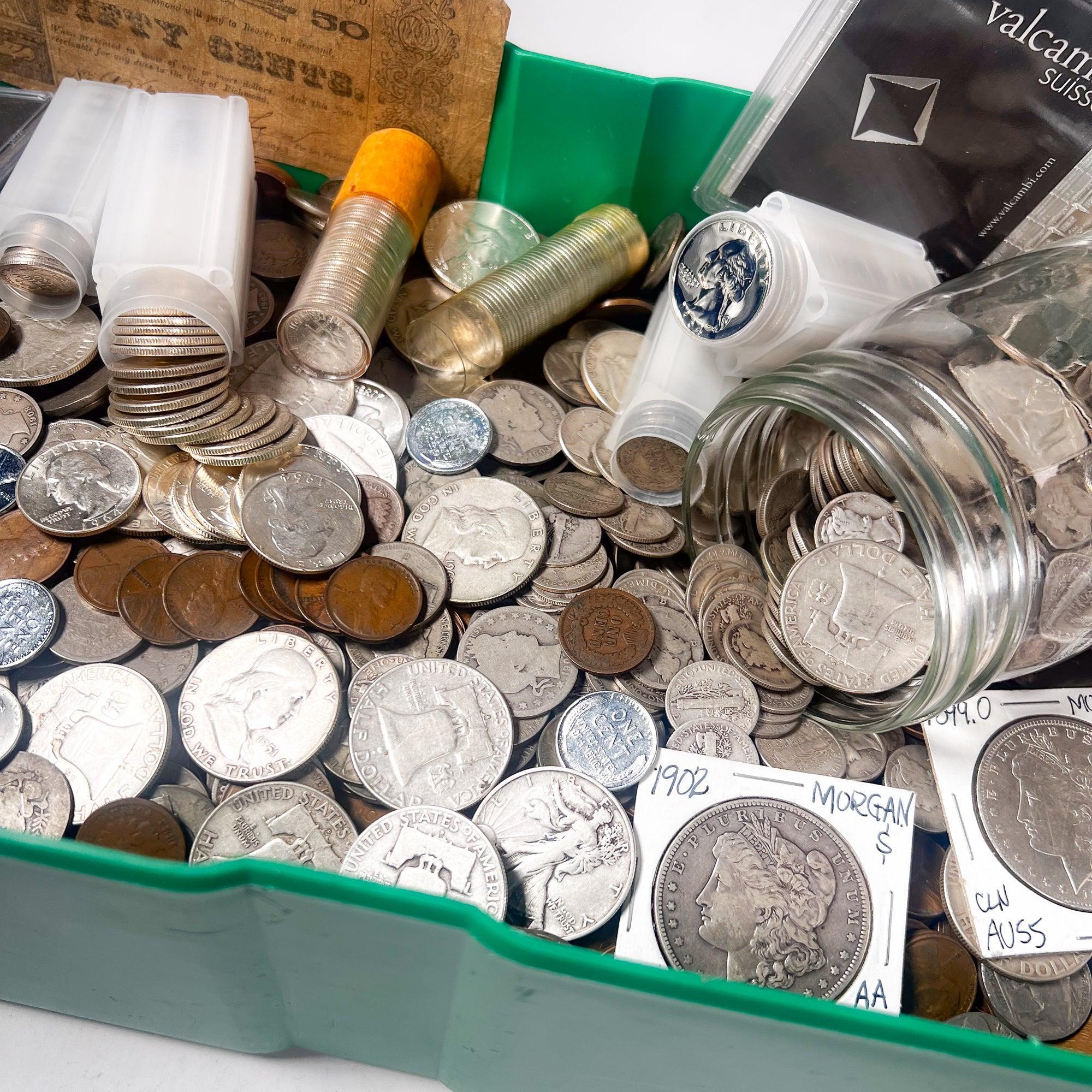Collecting Wheat Pennies: A Guide to American Heritage, Value, and Authentic Acquisition
For many discerning collectors and investors, the allure of American history is profoundly embodied in tangible assets. Among these, the humble yet historically rich Lincoln Cent, particularly its "Wheat Ear" reverse variant, stands out.
As an expert numismatist and trusted financial advisor, I understand the desire to connect with America's past, to own a piece of its legacy, and to ensure that such an acquisition represents genuine value and authenticity.
This pursuit resonates deeply with patriotic values, much like those held by clients seeking to invest in historically significant assets free from misrepresentation or counterfeits.
This guide will meticulously navigate the landscape of collecting wheat pennies, illuminating their historical significance, factors determining their value, and the critical importance of authentic acquisition to safeguard your investment and heritage.
The Enduring Appeal of the Wheat Penny: An American Icon
The Lincoln Cent series, first minted in 1909, marks a pivotal moment in U.S. coinage history. It ushered in the first widespread depiction of a real person—Abraham Lincoln—on a circulating American coin. This change from allegorical figures to a beloved historical statesman underscored a profound connection to American heritage and a burgeoning sense of national identity at the turn of the 20th century.
The initial design, crafted by Victor David Brenner, not only honored the centennial of Lincoln's birth but also introduced an artistic departure from previous coin designs. While the obverse, featuring Lincoln’s stoic profile, captured national sentiment, it was the reverse, with its iconic twin stalks of wheat, that gave the coin its enduring nickname: the "wheat penny." This motif, symbolizing national prosperity and agriculture, resonated deeply with the American populace. For over half a century, the wheat penny served as a daily reminder of both historical gravitas and the nation's industrious spirit.
Today, the lasting cultural and numismatic appeal of the "Wheat Ear" reverse remains undiminished. These coins are not merely currency; they are miniature time capsules, windows into the daily lives and economic realities of early 20th-century America. For many, wheat pennies serve as an accessible and engaging entry point into the fascinating world of coin collecting, or numismatics, offering a tangible link to a bygone era. Specific rare wheat pennies, however, can command significant sums, elevating them beyond simple curiosities.
A Brief History of the Lincoln Cent (1909-1958)
The inception of the Lincoln Cent in 1909 was a direct response to President Theodore Roosevelt's desire to beautify American coinage and commemorate the centennial of Abraham Lincoln's birth. It replaced the venerable Indian Head Cent, which had been in circulation since 1859, signaling a new artistic and historical direction for U.S. currency.
Design Evolution and Key Features
The Lincoln cent immediately distinguished itself with its innovative design elements.
- Obverse: The coin's front features the iconic right-facing portrait of Abraham Lincoln, meticulously sculpted by Victor David Brenner. This enduring image has remained largely unchanged for over a century, a testament to its artistic merit and public acceptance.
- Reverse: The reverse of the coin, from 1909 to 1958, showcased Brenner's elegant "Wheat Ear" design. This motif comprises two prominent stalks of wheat framing the words "ONE CENT" and "UNITED STATES OF AMERICA," signifying national bounty and unity.
Minting Locations and Production
The U.S. Mint produced wheat pennies at three primary facilities, each identifiable by its unique mint mark, or the lack thereof.
- Philadelphia Mint: Coins struck at the Philadelphia Mint typically bear no mint mark. These issues often represent the highest mintage figures for a given year.
- Denver Mint: Coins from the Denver Mint feature a "D" mint mark located below the date on the obverse.
- San Francisco Mint: Similarly, coins produced at the San Francisco Mint carry an "S" mint mark, also found below the date.
Understanding the mintage figures across different periods is crucial for assessing scarcity. Some years saw tens or hundreds of millions of cents produced, while others, particularly during wartime or economic downturns, had significantly lower mintages, laying the groundwork for future rarity.
Material Composition Changes
Throughout its nearly 50-year run, the wheat penny underwent a notable change in its material composition. Initially, the coins were composed of 95% copper and 5% tin and zinc, a composition that largely held until 1943. During World War II, a critical shortage of copper for the war effort necessitated a temporary shift. For one year, in 1943, Lincoln cents were struck from steel coated with zinc, resulting in a distinctively silver-colored coin. This anomaly makes the 1943 steel cent a unique, if not necessarily rare, piece of U.S. coinage history, easily distinguishable from its copper brethren. Following 1943, the copper composition largely returned, though the specific alloy was adjusted slightly in subsequent years.
Identifying Key Dates and Mint Marks: What to Look For
For anyone serious about collecting wheat pennies, the ability to accurately identify key dates and mint marks is paramount. These specific combinations are often the primary drivers of a coin's numismatic value, distinguishing a common cent from a truly valuable specimen.
Understanding Mint Mark Locations and Varieties
The mint mark is a small letter indicating where a coin was struck. Its correct identification is fundamental.
- Placement of "D" and "S" Mint Marks: On wheat pennies, the "D" for Denver and "S" for San Francisco are consistently found on the obverse, directly below the date. A clear, legible mint mark is vital for identification and can significantly impact the coin's worth.
- Absence of a Mint Mark for Philadelphia Issues: It is important to remember that coins minted in Philadelphia typically do not carry a mint mark. Therefore, a wheat penny without a "D" or an "S" below the date originated from the Philadelphia Mint.
Key Date Wheat Pennies and Their Significance
Certain date and mint mark combinations are exceptionally rare due to low mintage figures, high demand, or historical significance. These are often referred to as "key dates."
- 1909-S VDB: Arguably the most famous and rarest wheat penny, the 1909-S VDB cent carries Victor David Brenner's initials (VDB) prominently on the reverse, below the wheat stalks. Public outcry led to the rapid removal of these initials, making the San Francisco mint mark variant particularly scarce.
- 1914-D: Known for its remarkably low mintage figure, the 1914-D is another cornerstone key date for serious collectors. Its scarcity ensures its high value, especially in higher grades.
- 1931-S: Similar to the 1914-D, the 1931-S is distinguished by a low mintage, making it highly sought after by those seeking to complete a full date and mint mark collection.
- Other Significant Key Dates: This category also includes other elusive issues such as the 1909-S (without VDB), 1914-S, the infamous 1922-D "no D" (a rare variety where the "D" mint mark is missing due to a filled die), and the visually striking 1955 Doubled Die Obverse, an error coin where the dies shifted during striking, creating a distinct doubling of the date and inscriptions.
Semi-Key Date Wheat Pennies
Beyond the undisputed key dates, there are "semi-key" issues that, while not as rare as their counterparts, are still considerably less common than average dates and are highly sought after. These often include coins with relatively low mintage figures compared to their contemporaries, such as certain "S" mint issues from the 1910s and 1920s, or "D" mint issues from the 1920s and 1930s. The precise mintage figures, readily available in resources like the Red Book (A Guide Book of United States Coins), play a crucial role in determining their scarcity and, consequently, their enhanced value.
Recognizing common varieties and error coins, such as doubled dies (where parts of the design appear doubled) or repunched mint marks (where the mint mark was struck more than once in slightly different positions), adds another layer of intrigue and potential value to collecting wheat pennies. These anomalies, though often subtle, are highly prized by numismatists.
Understanding Wheat Penny Values: Factors Influencing Worth and Scarcity
Deciphering wheat penny values involves a nuanced understanding of several interconnected factors. It's a precise calculation, not mere speculation, guided by established numismatic principles.
Primary Value Determinants
The worth of a wheat penny is not static; it is a dynamic reflection of several key attributes.
- Rarity: This is perhaps the most significant factor. Rarity is primarily driven by low mintage figures—how many coins were originally produced. However, it is equally influenced by survival rates; how many of those original coins still exist today, particularly in collectible condition. The fewer coins available, the higher their potential value.
- Condition (Grade): The state of preservation directly correlates with value. A coin in pristine, uncirculated condition will always command a significantly higher price than a heavily circulated example of the same date and mint mark. This concept is so critical that an entire system of coin grading has been developed to standardize its assessment.
- Demand: Collector interest and prevailing market trends play a substantial role. A sudden surge in interest for a particular series or type of coin can drive up demand and, consequently, prices. Conversely, waning interest can stabilize or even depress values.
- Historical Significance and Provenance: Beyond simple rarity, some coins carry added weight due to their historical context or a documented history of ownership (provenance). A coin with a verifiable connection to a significant event or a renowned collection can command a premium.
The Role of Copper Value
For most common-date, heavily circulated wheat pennies, particularly those from the later years of the series, their intrinsic metal value—the copper value—might be close to or, in some cases, even exceed their face value. While this is a practical consideration for very common cents, it is crucial to distinguish this from true numismatic value. Numismatic value, driven by rarity, condition, and demand, far surpasses melt value for any coin of genuine collector interest, especially for rare wheat pennies or high-grade examples. An investor focused solely on copper content would overlook the far greater potential of numismatic appreciation.
Consulting Numismatic Resources
Accurate valuation requires reliable resources. Two are indispensable.
- The "Red Book" (A Guide Book of United States Coins): This annual publication by R.S. Yeoman is considered the definitive guide for U.S. coin collecting. It provides comprehensive mintage figures, historical context, and estimated values for various grades of U.S. coins, including every wheat penny. It is a fundamental reference for both novice and experienced collectors.
- Online Pricing Guides and Auction Results: For the most current market insights, consulting reputable online pricing guides and analyzing recent auction results from established numismatic platforms is essential. These resources offer a real-time pulse on what buyers are actually paying for specific coins, providing a more dynamic view than the typically more conservative estimates found in printed guides.
Distinguishing between common dates and rare wheat pennies requires careful research and a keen eye for detail. A penny from 1957-D, for instance, might be common, while a 1914-D or a 1909-S VDB is a true rarity, with values ranging from a few dollars to tens of thousands.
The Art of Grading Wheat Pennies: Essential Principles for Authenticity and Condition
The foundational importance of accurate grading cannot be overstated for any serious collector or investor. It is the standardized language of numismatics, providing a universal benchmark for a coin's condition and, by extension, its value. Understanding how to grade wheat pennies is fundamental to informed acquisition.
Introduction to Coin Grading Standards
The modern system of coin grading largely adheres to the Sheldon Scale, a numerical scale from 1 to 70, with 70 representing a perfect, flawless coin. For wheat pennies, understanding the key terminology is vital.
Circulated Grades:
- Good (G): Heavy wear, design elements faint but identifiable.
- Very Good (VG): Design outlines clear, major details worn flat.
- Fine (F): Moderate even wear, some detail visible.
- Very Fine (VF): Light to moderate wear, all major details sharp.
- Extremely Fine (EF/XF): Light wear on high points, some luster may remain.
- About Uncirculated (AU): Traces of wear on highest points, significant original luster.
Uncirculated Grades:
- Mint State (MS): This is the term for uncirculated coins, typically followed by a numerical grade from 60 to 70 (e.g., MS-63, MS-65). Within the MS grades, specific considerations for Lincoln cents include the sharpness of Lincoln's cheekbone, the distinctness of the hair details, and particularly, the clarity of the "wheat lines" on the reverse. Full and sharp wheat lines are indicative of a strong strike and higher quality.
- Proof (PF): Coins struck specifically for collectors, characterized by highly polished fields and frosted devices. Proof wheat pennies are rare and highly prized.
Factors Affecting a Coin's Grade
A coin's numerical grade is the culmination of assessing several critical factors.
- Wear and Tear from Circulation: The degree to which the highest points of the coin's design have been rubbed down due to handling and use. This is the primary determinant for circulated grades.
- Surface Preservation: This includes the presence of scratches, nicks, dents, or environmental damage such as corrosion, spotting, or significant toning that detracts from the coin's appeal. Cleaning a coin, even gently, is considered damage and will drastically reduce its numismatic value.
- Strike Quality from the Mint: How well the coin's design was impressed onto the planchet during the minting process. A weak strike can result in indistinct details, even on an uncirculated coin, impacting its grade.
- Original Luster and Toning: For uncirculated coins, the presence of original mint luster—the cartwheel effect seen when a coin is tilted in light—is crucial. Toning, the natural patina that develops on copper over time, can be either attractive or detrimental, depending on its evenness and coloration.
The Role of Professional Coin Grading Services (PCGS and NGC)
Given the subjectivity that can arise in grading and the significant impact of grade on value, professional third-party grading services have become indispensable.
- Benefits of Third-Party Authentication and Encapsulation: Services like PCGS (Professional Coin Grading Service) and NGC (Numismatic Guaranty Company) offer independent, expert evaluations. They authenticate the coin as genuine, assign a standardized grade, and encapsulate it in a tamper-evident, sonically sealed holder (a "slab"). This process provides an objective assessment, protecting both buyer and seller.
- Ensuring Accurate Representation and Liquidity: Professional grading ensures that a coin is accurately represented, eliminating disputes over condition. This standardization enhances liquidity, making professionally graded coins easier to buy, sell, and trade in the market with confidence. For investors concerned about misrepresentation, this third-party validation is crucial.
- Expertise in Numismatic Grading for Trusted Sources: Reputable dealers and exchanges often feature coins that have been professionally graded. This highlights their commitment to authenticity and transparent transactions, leveraging the expertise of the most trusted names in numismatics for their offerings.
Addressing concerns about misrepresentation starts with understanding and utilizing professional grading. It reinforces the need for expert authentication, transforming a subjective opinion into an objective, verifiable standard.
Strategies for Building a Wheat Penny Collection: Approaches for Collectors and Investors
Collecting wheat pennies can be approached with diverse methods, catering to various goals—from a casual hobbyist seeking historical connection to a serious investor focused on wealth preservation.
Common Collection Approaches
The beauty of wheat pennies lies in the myriad ways one can choose to collect them.
- Date and Mint Mark Set: A popular and challenging goal is to complete a full set of every date and mint mark issued for the wheat penny series (1909-1958). This requires diligent searching, particularly for the key dates and semi-key dates.
- Condition-Specific Sets: Some collectors choose to focus on acquiring coins in a particular condition, such as all uncirculated (MS-65 or higher) examples, or perhaps all high-grade circulated coins (VF or EF). This approach emphasizes quality over sheer quantity.
- Error Coin Collections: For those fascinated by the anomalies of the minting process, collecting error coins like doubled dies (e.g., the 1955 Doubled Die Obverse), off-center strikes, or repunched mint marks offers a unique challenge.
- Type Sets: A more concise approach might be to collect one example of each major type or composition change, such as a 1909-S VDB, a common copper cent, and a 1943 steel cent.
Investment Perspective: Wealth Preservation Through Numismatics
Beyond the joy of the hobby, coin collecting can be a prudent avenue for wealth preservation, particularly with historically significant assets like wheat pennies.
- Wheat Pennies as Tangible Assets and Their Historical Performance: Unlike volatile stocks or abstract digital assets, physical coins represent tangible wealth. Historically, rare and high-grade numismatic items have demonstrated a strong track record of value appreciation, often outperforming traditional investments over the long term, especially during periods of economic uncertainty. They are not susceptible to the same market forces as paper currency or digital assets.
- The Long-Term Value Appreciation of Rare and High-Grade Issues: While common wheat pennies may hold modest value, truly rare wheat pennies and those in exceptional, professionally graded condition have shown significant appreciation. Their finite supply, combined with consistent collector demand, creates a powerful upward pressure on value. This makes them attractive as a hedge against inflation and a diversified component of a robust investment portfolio.
- Diversification of Investment Portfolios with Historically Significant Assets: Including vintage U.S. coins in an investment portfolio offers diversification. They are non-correlated assets, meaning their value often moves independently of traditional financial markets. For investors who value a tangible connection to American history, these coins represent not just financial assets but also a piece of national heritage.
Setting realistic goals and budgeting responsibly are crucial. Whether aiming for a complete date set or a few high-grade rarities, a well-planned approach ensures a rewarding and potentially profitable experience in collecting wheat pennies.
Where to Acquire Authentic Wheat Pennies: Trust and Reputable Sources
For any collector or investor, especially those with legitimate concerns regarding authenticity and accurate representation, the choice of acquisition source is paramount. The market, particularly online, can be fraught with misrepresented items, outright counterfeits, or coins with exaggerated grades. Prioritizing trustworthy sources is not merely advisable; it is essential for safeguarding your investment.
The Importance of Trustworthy Sources
The numismatic market, like any other, has its pitfalls. The proliferation of sophisticated counterfeits, particularly of rare wheat pennies, and the prevalence of inaccurate or inflated grades, poses a significant risk. Purchasing from an unverified source can lead to acquiring worthless fakes or overpaying for common coins. Every purchase, regardless of its perceived value, warrants thorough due diligence. This includes researching the seller, examining high-resolution images, and, ideally, only purchasing professionally graded coins for high-value items.
Reputable Acquisition Channels
Navigating the market requires knowing where to look for genuinely authentic and accurately described vintage U.S. coins.
- Specialized Numismatic Dealers: These are often the safest and most reliable sources. Reputable dealers possess deep expertise, often having years, if not decades, of experience in the field. They maintain stringent authentication processes, ensuring that every coin they sell is genuine. Midwest Precious Metals Exchange, for instance, specializes in vintage U.S. coins and currency, bringing profound expertise in numismatic grading and an unwavering commitment to authentication for every item listed. This commitment provides an invaluable layer of trust and assurance for collectors.
- Professional Coin Shows: Attending major coin shows offers unparalleled opportunities for in-person inspection of coins and direct consultation with multiple expert dealers. It allows for comparison, negotiation, and building relationships within the numismatic community.
- Accredited Online Marketplaces: While online purchasing requires caution, many reputable online marketplaces exist. Criteria for identifying legitimate platforms include strong buyer protection policies, verifiable seller ratings and reviews, and a clear return policy. Prioritize sellers who deal in professionally graded and slabbed coins from NGC or PCGS.
- Certified Auction Houses: For high-value or exceptionally rare items, certified auction houses provide a robust layer of verification. These houses employ their own numismatic experts who authenticate and grade coins before they are offered for sale, further reducing the risk of acquiring misrepresented items.
When considering a new source, always ask pointed questions about their authentication processes, grading standards, and return policies. Be wary of sources that offer "too good to be true" deals or are vague about their inventory's provenance. A seller's unwavering commitment to authentication for every item listed, backed by expert knowledge and transparent practices, is the cornerstone of a trustworthy acquisition channel.
Preserving Your Wheat Penny Collection: Care and Storage
Once you have meticulously acquired authentic wheat pennies, preserving their condition and value becomes paramount. Proper care and storage are not just about aesthetics; they are critical for maintaining the intrinsic worth of these historical assets for generations to come.
Proper Handling Techniques
The most significant damage to a coin often occurs during handling. Simple precautions can prevent irreversible harm.
- Always Hold Coins by the Edges: Never touch the obverse (front) or reverse (back) surfaces of a coin with bare hands. The natural oils and acids from your skin can leave permanent fingerprints, which are nearly impossible to remove without damaging the coin's surface and significantly reducing its numismatic value.
- Use Cotton Gloves: Always use soft, lint-free cotton gloves when handling raw (unslabbed) coins. This provides a protective barrier against skin oils and prevents accidental slippage.
Appropriate Storage Materials
The right storage materials protect coins from physical damage and environmental degradation.
- Acid-Free, PVC-Free Holders: Coins should be stored in materials specifically designed for coin preservation. Common examples include 2x2 cardboard holders with Mylar windows (stapled shut for a secure fit) or Mylar (polyester) flips. Critically, avoid holders made of PVC (polyvinyl chloride), which can leach plasticizers over time, causing a sticky, greenish film to develop on coins—a phenomenon known as "PVC damage."
- Slabbed Coins for Optimal Protection: Coins encapsulated by professional grading services like PCGS and NGC are already housed in inert, archival-safe plastic holders. These "slabs" provide superior physical and environmental protection, making them ideal for high-value or key-date coins.
- Numismatic Albums and Display Cases: For organizing and displaying collections, use albums and display cases specifically designed for coins. These typically feature inert pages with individual slots and are made from materials that will not harm the coins.
Environmental Considerations
The environment in which your collection is stored plays a crucial role in its long-term stability.
- Storing Coins in Stable, Dry Environments: Fluctuations in temperature and humidity are detrimental. An environment that is too humid can promote corrosion, while excessive dryness can cause some materials to become brittle. A stable, moderate temperature and low-humidity environment (e.g., a climate-controlled room) is ideal.
- Avoiding Extreme Temperature Fluctuations and Humidity: Basements and attics are generally poor storage locations due to their susceptibility to wide swings in temperature and humidity.
- Protection from Light Exposure: Prolonged exposure to direct sunlight or harsh artificial light can accelerate toning or cause other undesirable chemical reactions, particularly on copper coins. Store your collection in a dark, cool place.
The long-term impact of proper preservation on a collection's value cannot be overstated. A well-preserved coin maintains its grade and eye appeal, safeguarding its numismatic worth for future generations.
The Enduring Legacy of the Wheat Cent in American Numismatics
The journey through the world of collecting wheat pennies reveals more than just the pursuit of monetary value; it is an immersion into the rich tapestry of American history. From their initial minting in 1909 to their discontinuation in 1958, these humble copper cents served as a daily reminder of a nation's growth, struggles, and enduring spirit. They represent a tangible connection to the past, reflecting the centennial of Abraham Lincoln's birth and the agricultural strength symbolized by Victor David Brenner's elegant "Wheat Ear" reverse.
The continuing appeal of the wheat penny to generations of collectors and investors stems from this profound historical and cultural significance. For many, they are the gateway to numismatics, sparking a lifelong passion for coin collecting and deeper exploration of U.S. coinage history. For others, particularly discerning investors, these vintage U.S. coins offer a compelling blend of historical resonance and potential for wealth preservation. Their finite supply, coupled with consistent demand for rare wheat pennies and high-grade examples, solidifies their position as valuable, tangible assets.
Ultimately, whether you are drawn to the aesthetic beauty, the historical narrative, or the investment potential, the intrinsic value of these vintage U.S. coins transcends their face value. They are not merely pieces of metal but artifacts that embody a segment of American heritage, offering a unique opportunity to own a piece of that legacy.
Explore our curated selection of authenticated vintage U.S. coins, including rare wheat pennies, at Midwest Precious Metals Exchange for trusted acquisitions. Our commitment to expertise in numismatic grading and rigorous authentication processes ensures that every item we offer represents genuine value and provides the confidence you deserve in your pursuit of American history.
Frequently Asked Questions
What makes a wheat penny valuable?
A wheat penny's value is primarily determined by its rarity (driven by low mintage figures and survival rates), its condition (grade), collector demand, and any unique historical significance or errors. While common dates hold minimal value, rare wheat pennies and high-grade examples can be worth significantly more.
How can I identify a rare wheat penny?
Identifying rare wheat pennies involves checking the date and mint mark combination. Key dates like the 1909-S VDB, 1914-D, and 1931-S are notably scarce due to low mintage. Certain error coins, such as the 1955 Doubled Die Obverse or the 1922-D "no D" variety, are also highly sought after. Consult a Red Book or reputable online guides for specific mintage figures.
What is coin grading and why is it important for wheat pennies?
Coin grading is the standardized assessment of a coin's condition, typically using the Sheldon Scale from 1 to 70. It is crucial for wheat pennies because the grade directly impacts a coin's value. Professional grading services like PCGS and NGC provide objective authentication and condition assessment, which instills confidence for buyers and sellers, particularly for valuable or rare wheat pennies.
What are the best ways to preserve my wheat penny collection?
Proper preservation is vital for maintaining value. Always handle coins by their edges, ideally with cotton gloves, to avoid transferring skin oils. Store them in acid-free, PVC-free holders or professional "slabs" from NGC or PCGS. Keep your collection in a stable, dry environment, protected from extreme temperature fluctuations and direct light.
Looking to explore wheat pennies? Check out some of our selection here!












